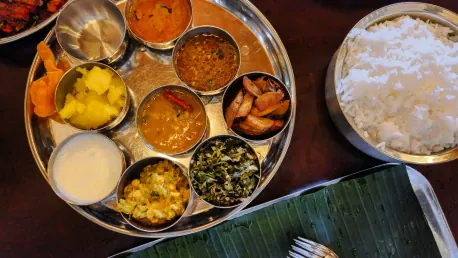The rise in the popularity of Indian cuisine in New York City is nothing short of remarkable. Indian restaurants, both new and old, have become some of the most desirable dining spots in the city, attracting food enthusiasts and curious diners alike. The evolution of Indian dining has seen a shift from traditional, often Eurocentric representations to a more authentic showcase of regional dishes, drawing in a wider array of patrons. Here, we explore how this transformation occurred and the influential players behind it.
The Evolution of Indian Dining
From Classic to Contemporary
Indian cuisine in New York has undergone a significant transformation, evolving from traditional, often Eurocentric representations to a more authentic showcase of regional dishes. Historically, many Indian restaurants in the city catered to Western tastes, presenting a refined version of Indian dishes that aligned more closely with international dining norms. This approach, though successful to a degree, often meant that the true depth and diversity of Indian cuisine were not fully represented, leaving many regional flavors and culinary traditions unexplored.
In recent years, however, there has been a conscious shift driven by restaurateurs and chefs who are dedicated to bringing genuine flavors and cultural experiences to their diners. This new wave of Indian dining emphasizes authenticity, showcasing dishes that are deeply rooted in the culinary traditions of various Indian states. Chefs are increasingly drawing inspiration from their personal histories and regional cuisines, resulting in menus that offer a much richer and more diverse portrayal of Indian food. This change is evident in the popularity of dishes that were once considered too bold or unfamiliar for mainstream dining, reflecting a growing appreciation for genuine, unadulterated Indian flavors.
Embracing Bold Regional Flavors
The transformation is particularly notable in the increasing prominence of bold, homestyle dishes typically found in different regions of India. These flavors, which are characterized by robust spices and distinct culinary techniques, have gained significant popularity among New York diners who are eager to explore new culinary horizons. For example, dishes from Kerala, Tamil Nadu, and Goa that feature ingredients and preparation methods unique to these locales are becoming staples in many Indian restaurants across the city.
This embrace of regional cuisine is driven by both a desire for authenticity and a response to the adventurous tastes of modern diners. As people become more interested in experiencing the depth of Indian cuisine, chefs are more inclined to introduce recipes that highlight the diverse gastronomic heritage of India. This trend is reflected in menus that feature dishes like mathi varuthathu (sardine fry from Kerala), eral thokku (fiery tiger prawn from Tamil Nadu), and bheja fry (spicy goat brains from Maharashtra). Such offerings, once considered too niche, are now celebrated for their bold flavors and cultural significance.
Influential Players
Unapologetic Foods
Roni Mazumdar and Chintan Pandya’s Unapologetic Foods group has played a pivotal role in the culinary renaissance of Indian cuisine in New York. Their approach is centered around introducing restaurants that challenge preconceived notions about Indian food and present ambitious menus that celebrate regional specialties. Establishments like Semma and Dhamaka have been crucial in redefining Indian dining in the city, offering dishes that are unapologetically bold and homestyle.
Unapologetic Foods’ success lies in its commitment to authenticity and its willingness to cater to evolving diner preferences. By presenting dishes that are true to their roots and unmodified for Western palates, Mazumdar and Pandya have fostered a deeper appreciation for Indian cuisine among New Yorkers. Their restaurants not only serve food but also tell stories of the regions and cultures they represent, adding an educational and experiential dimension to the dining experience. This approach has resonated strongly with both Indian and non-Indian diners, leading to a significant shift in how Indian food is perceived and enjoyed in the city.
Chefs Leading the Charge
Notable chefs such as Chintan Pandya and Vijay Kumar bring their culinary expertise and personal stories to the dishes they create, playing a crucial role in the evolving Indian dining scene. Pandya’s work at Adda, for example, features bold dishes such as kale pakora chaat and spicy bheja fry (goat brains), which have become popular despite initial doubts about customer readiness. Similarly, Kumar draws inspiration from his childhood in rural Tamil Nadu to create a menu at Semma that includes authentic dishes like nathai pirattal (snails with ginger and tamarind) and thinai khichdi, reflecting his deep connection to his culinary heritage.
These chefs’ commitment to authenticity strikes a chord with diners, fostering a deep appreciation for Indian cuisine. By offering dishes that are rich in cultural significance and rooted in regional traditions, they provide diners with a genuine taste of India. This approach not only elevates the culinary experience but also contributes to a broader understanding and appreciation of Indian culture. Their innovative menus and dedication to authenticity have made a lasting impact on New York’s dining scene, positioning Indian cuisine as a dynamic and diverse culinary option.
New Entrants Making Waves
Explosion of New Restaurants
The city’s dining scene has seen a spate of new Indian restaurants that celebrate diverse regional cuisines, each offering distinct culinary experiences. Establishments like Chatti, Bungalow, Kanyakumari, and Jazba highlight different aspects of India’s rich food traditions, contributing to the growing popularity of Indian cuisine in New York. Chatti, for instance, draws inspiration from the toddy shops of North Kerala, serving dishes like mathi varuthathu (sardine fry) and kappa vada (tapioca patties) that evoke the culinary heritage of the region.
Similarly, Bungalow by Vikas Khanna offers innovative takes on traditional dishes while celebrating Indian culture through themed events such as Eid al-Fitr and Navratri feasts. Kanyakumari focuses on South Indian coastal fare, presenting bold spice blends and authentic preparations that showcase the unique flavors of the region. Jazba, the younger sibling to the upscale Junoon, combines vibrant interiors with street hawker-inspired dishes, reflecting the diversity and vibrancy of India’s culinary landscape. These new entrants are redefining Indian dining in New York, each contributing to the city’s dynamic and evolving culinary scene.
Focus on Community and Culture
Many new restaurants emphasize community and cultural pride, embodying the familial and communal aspects of Indian food. Projects like the Brooklyn Curry Project highlight this trend by creating a welcoming space for anyone to enjoy hearty, home-style meals. Founders Shwetha and Venkat Raju started the project to connect with others and share their culinary heritage, offering family-style lunches that feature heirloom recipes and special ingredients from India. This approach not only provides diners with authentic Indian flavors but also fosters a sense of community and cultural connection.
These restaurants are more than just dining establishments; they are spaces where culture and community are celebrated. Through their emphasis on familial traditions and communal dining experiences, they create an environment that is inclusive and welcoming, inviting diners to experience the depth and warmth of Indian hospitality. This focus on community and culture adds an extra layer to the dining experience, making it not just about the food but also about the shared experiences and connections that come with it. The rise of such establishments reflects a broader cultural movement, where food serves as a means to celebrate and reclaim identity.
Pushing the Boundaries of Taste
Innovative and Experimental Menus
Chefs are not just sticking to traditional recipes; they are also experimenting with innovative and contemporary interpretations of classic dishes. This level of culinary creativity keeps the dining experience fresh and exciting for patrons. For example, at Passerine, Chef Chetan Shetty uses flavors from his hometown of Pune to offer dishes like Konkani monkfish curry in a contemporary setting with a stylish, low-lit ambiance. The restaurant emphasizes that Indian cuisine can be both sophisticated and exciting, aligning with modern dining trends and appealing to a diverse clientele.
Innovation in Indian cuisine is not limited to presentation; it also involves reimagining traditional ingredients and cooking techniques. This experimental approach allows chefs to create unique and novel dishes that surprise and delight diners, pushing the boundaries of what Indian food can be. By blending traditional flavors with modern culinary techniques, chefs are able to offer a menu that is both familiar and innovative, providing a fresh perspective on Indian cuisine. This willingness to experiment and innovate reflects the dynamic nature of New York’s dining scene and the adaptability of Indian cuisine to new trends and tastes.
Catering to Adventurous Palates
Modern diners in New York are increasingly adventurous, showing a willingness to try less familiar and bolder flavors. This trend has emboldened chefs to introduce specialty dishes that might have been considered too niche just a few years ago. Diners’ growing curiosity and enthusiasm for authentic and bold flavors have paved the way for dishes that are deeply rooted in regional traditions, offering a genuine taste of India. This shift is evident in the popularity of dishes like spicy goat brains, fiery tiger prawns, and homestyle snail preparations, which were once considered too exotic for mainstream dining.
The willingness of New York diners to embrace diverse and unfamiliar flavors has created an environment where chefs feel empowered to push culinary boundaries. This adventurousness not only broadens the culinary landscape but also enriches the dining experience, allowing patrons to explore and appreciate the full spectrum of Indian cuisine. The trend towards adventurous dining reflects a broader shift in the city’s culinary culture, where authenticity and bold flavors are increasingly valued. Chefs are responding to this shift by introducing menus that celebrate the complexity and richness of Indian culinary traditions, offering a dining experience that is both exciting and deeply satisfying.
The Impact of Legacy Establishments
Paving the Way
Legacy establishments like Junoon have laid the foundation for the current wave of modern Indian restaurants, carving out a space for elegant and refined interpretations of Indian cuisine within the fine dining scene. These early pioneers in upscale Indian dining demonstrated that Indian food could achieve high culinary standards and success in a competitive market like New York. Junoon’s sophisticated approach to Indian cuisine, coupled with its dedication to authenticity, set the stage for contemporary chefs and restaurateurs to innovate and push the boundaries even further.
The success of establishments like Junoon has validated the potential of Indian cuisine in the fine dining sector, encouraging new ventures to explore uncharted territories within the culinary realm. By proving that Indian food can be both elegant and deeply flavorful, these legacy restaurants have created opportunities for a new generation of chefs to experiment with bold regional flavors while maintaining high culinary standards. Their influence extends beyond their own kitchens; they have inspired a cultural movement that celebrates the richness and diversity of Indian culinary traditions, paving the way for further innovation and exploration.
Reclaiming Identity
The rise of Indian cuisine in New York reflects a broader cultural movement, signifying a reclaiming of identity by the Indian community and a celebration of their rich culinary heritage. This movement is characterized by a newfound pride in authentic regional dishes and a commitment to presenting Indian food in its true form, without modification for Western tastes. Restaurateurs and chefs are increasingly focused on showcasing their culinary traditions, drawing from personal histories and regional cuisines to create menus that offer a genuine taste of India.
The emphasis on authenticity and cultural pride has imbued New York’s dining scene with a sense of inclusivity and diversity, allowing diners to experience the depth and warmth of Indian hospitality. This trend reflects a broader societal shift towards valuing cultural heritage and identity, where food serves as a powerful means of expression and connection. The celebration of authentic Indian cuisine not only enriches the city’s culinary landscape but also fosters a deeper understanding and appreciation of Indian culture. It represents a reclaiming of identity and a recognition of the importance of cultural roots in shaping the dining experience.
Future of Indian Dining in New York
Excitement for What’s Next
With the ongoing success and increasing popularity of Indian restaurants in New York, the future looks bright. The city’s Indian culinary scene is poised for continued growth and diversification, with new openings and innovative ventures on the horizon. One highly anticipated arrival is London’s famed Dishoom, known for its casual yet iconic dishes that celebrate the vibrant flavors of Indian street food. The introduction of such establishments reflects the growing demand for authentic and diverse Indian cuisine, suggesting that New York’s dining scene will continue to evolve and expand.
The enthusiasm surrounding Indian cuisine in New York is driven by both diners and chefs, who are equally passionate about exploring and celebrating India’s extensive culinary heritage. This mutual excitement promises continued innovation and experimentation, with chefs pushing the boundaries of traditional recipes and diners embracing bold and unfamiliar flavors. The future of Indian dining in New York is not just about maintaining current trends but also about exploring new possibilities and celebrating the rich diversity of India’s culinary traditions.
Continuous Innovation
The surge in the popularity of Indian cuisine in New York City is truly remarkable. Once a niche in the diverse culinary landscape, Indian restaurants, whether newly established or long-standing, have emerged as some of the most coveted dining areas in the metropolis. This rise isn’t just about more people seeking Indian food; it’s about a profound shift in how Indian cuisine is presented and perceived.
Historically, Indian food in the city was often adapted to fit Western tastes, sometimes losing its authentic essence. However, in recent years, there has been a significant transformation. Chefs and restaurateurs are now focusing on highlighting the rich diversity of India’s regional dishes. This change has not only attracted food enthusiasts but also piqued the curiosity of many new diners willing to explore the expansive flavors of India.
Several influential figures in the food industry have been behind this shift. From celebrity chefs introducing authentic Indian flavors to high-profile establishments providing a genuine culinary experience, these actors have played pivotal roles. Their innovation and dedication to authenticity have helped reshape the narrative around Indian dining in NYC, turning it into a vibrant and essential part of the city’s food culture. Through this evolution, Indian cuisine has found its well-deserved place in New York City’s gastronomic heart.









